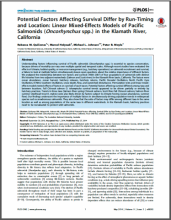Potential Factors Affecting Survival Differ by Run-Timing and Location: Linear Mixed-Effects Models of Pacific Salmonids (Oncorhynchus spp.) in the Klamath River, California

Understanding factors influencing survival of Pacific salmonids (Oncorhynchus spp.) is essential to species conservation, because drivers of mortality can vary over multiple spatial and temporal scales. Although recent studies have evaluated the effects of climate, habitat quality, or resource management (e.g., hatchery operations) on salmonid recruitment and survival, a failure to look at multiple factors simultaneously leaves open questions about the relative importance of different factors.
We analyzed the relationship between ten factors and survival (1980–2007) of four populations of salmonids with distinct life histories from two adjacent watersheds (Salmon and Scott rivers) in the Klamath River basin, California. The factors were ocean abundance, ocean harvest, hatchery releases, hatchery returns, Pacific Decadal Oscillation, North Pacific Gyre Oscillation, El Nin˜o Southern Oscillation, snow depth, flow, and watershed disturbance. Permutation tests and linear mixedeffects models tested effects of factors on survival of each taxon. Potential factors affecting survival differed among taxa and between locations. Fall Chinook salmon O. tshawytscha survival trends appeared to be driven partially or entirely by hatchery practices. Trends in three taxa (Salmon River spring Chinook salmon, Scott River fall Chinook salmon; Salmon River summer steelhead trout O. mykiss) were also likely driven by factors subject to climatic forcing (ocean abundance, summer flow). Our findings underscore the importance of multiple factors in simultaneously driving population trends in widespread species such as anadromous salmonids. They also show that the suite of factors may differ among different taxa in the same location as well as among populations of the same taxa in different watersheds. In the Klamath basin, hatchery practices need to be reevaluated to protect wild salmonids.
Quinones, R., M. Holyoak, M. L. Johnson, and P. B. Moyle. 2014. Potential Factors Affecting Survival Differ by Run-Timing and Location: Linear Mixed-Effects Models of Pacific Salmonids (Oncorhynchus spp.) in the Klamath River, California. PLoS ONE 9.
